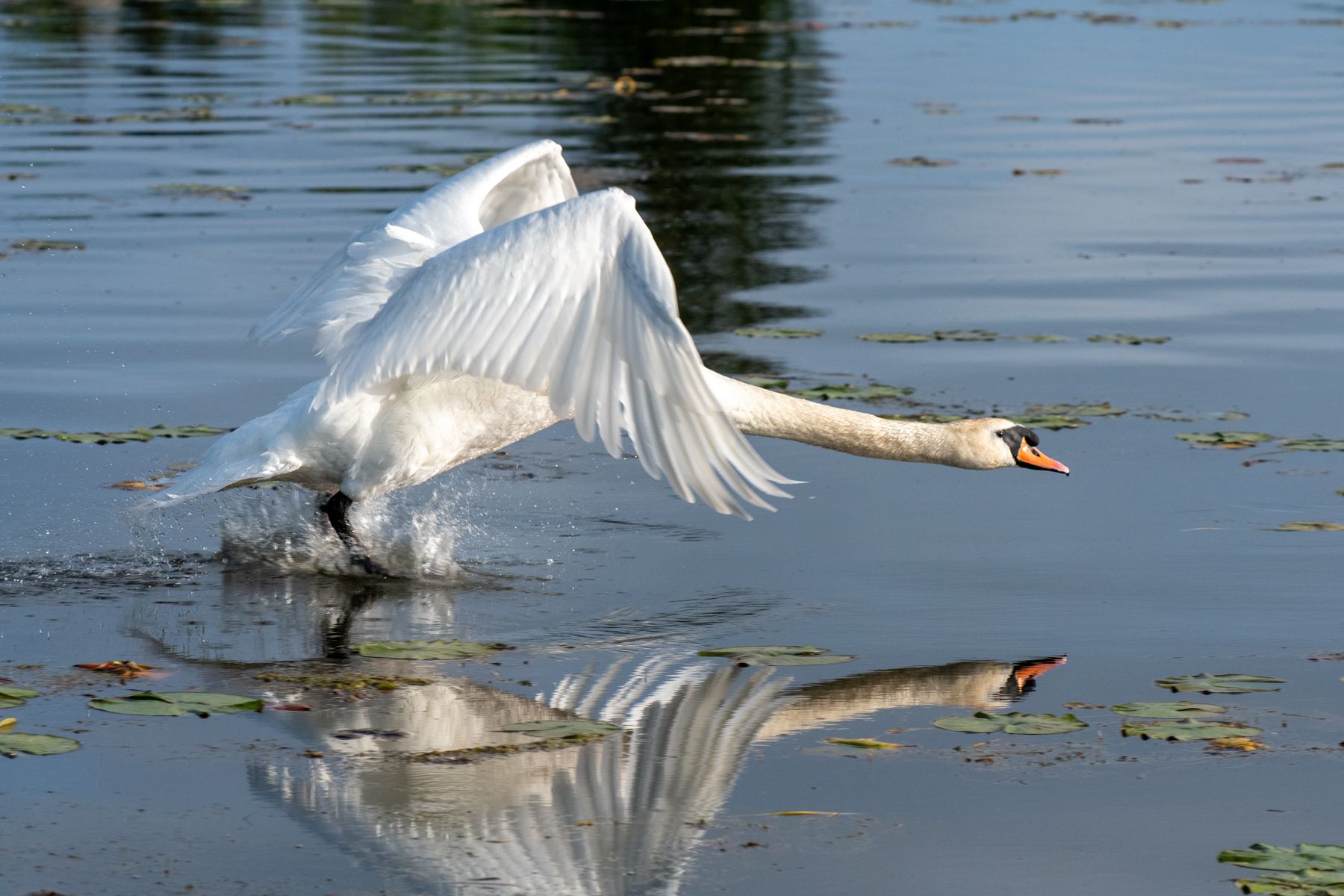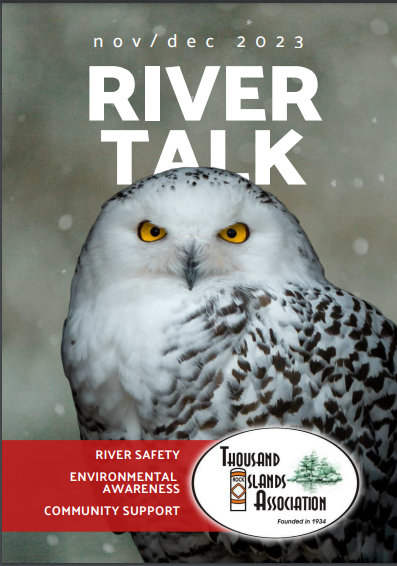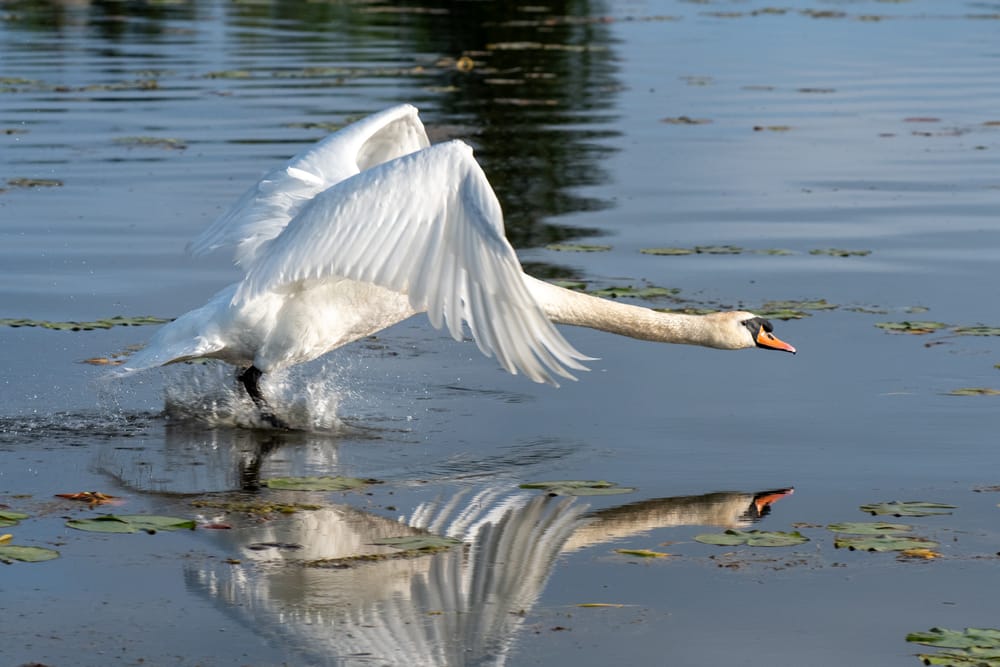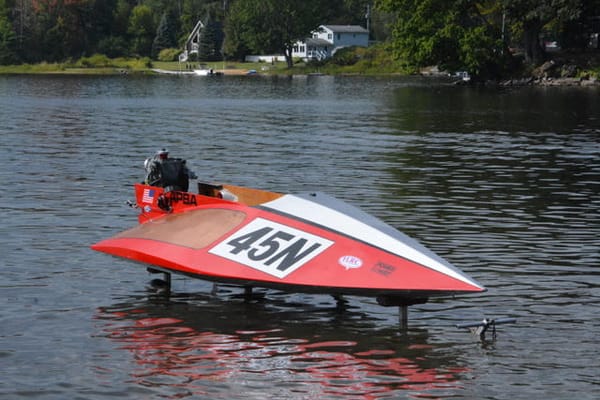Caution Swans Ahead!
by: Janet Smith Staples
Have you ever had an altercation with a swan? I have and so has another TIA [Thousand Islands Association] member whose story I am sharing here. This member had written to Queen’s university to find as much information out about these birds as possible.
I live in the Admiralty Group, across from Gananoque, on Tremont Island. This past summer, I had a very frightening experience early one morning (6:30) while kayaking around the big community island, where our cottage is located. I am 83 years old. I paddle not far from shore. My paddling is more meditative and peaceful than racing or tripping.
I came upon a family of 6 – 2 adults and 4 cygnets – who were feeding near the shore as I paddled along. They swam away in front of me a considerable distance. Then a strange thing took place. The male suddenly turned back, swam incredibly fast and aggressively, hissing, snorting, making a big feather and wing display, then turning his back to me, displaying big neck maneuvers also. He then faced me again, hissing. He came to within about 20 feet of me. I had stopped paddling, not wanting to seem aggressive.

A neighbour having tea in her cottage thought he might come directly at me and turn over the kayak, so she was watching closely.
I then began to paddle very slowly towards home, watching the swan. I came near a very, very large inflatable floating toy in front of another neighbour’s cottage and the swan stopped moving near me again. I think perhaps the colour, size, and height of it scared him.
He stopped but stayed near, about 40 feet away, as I came to my dock, which was very close. I was completing my morning paddle. I was quite rattled by this as was my young neighbour who came over to me. Had I been on the other side of the island, when most are often sleeping, and I was alone on the water, what might have happened?”
Her response came from Peter T. Boag, PhD, FRSC Prof. Emeritus of Biology, Queen’s University, Kingston, ON:
“I’m a retired bird biologist from Queen’s; I'm not sure I can offer much practical help, but I can make a few observations based on personal experience and my professional past. We live on a lake north of Kingston and just this summer, watched a similar display on the marsh below our house. A male Canada goose battled for better part of 30 minutes with a male swan trying to enter the marsh with its mate. Ultimately the goose won, and the swans retreated.
The aggressive swans are almost certainly Mute swans, a non-native species introduced to North America for display at zoos and parks. It is the largest swan species, indeed one of the largest birds in the world. They are highly territorial and very aggressive towards other waterbirds, and almost any other animal, including humans, if they perceive them as a threat to their mate, young, or nest site, especially during the March to August breeding season. Mute swan numbers have been increasing, and they now nest in many places in the greater Kingston area.
It is important to distinguish Mute swans from our two native swan species, the much smaller Tundra swan, which breeds in the far north but passes through our area spring and fall in numbers. The other native species is the Trumpeter swan, almost as large as the Mute, but much less aggressive. The Mute swans are considered an invasive species because their aggressive territoriality on marshes can exclude native waterfowl including our native swans, plus Mutes can be voracious feeders doing damage to wetland areas by overgrazing.
Not much to suggest in the way of safety, except to suggest to say that people learn to identify Mute swans (distinctive orangey red beak with black knob) from the other swans (all black beaks). Stay well away from Mutes, especially during the breeding season, and super-especially if they have cygnets (young) when they can become particularly aggressive. The full-grown males are able to break one’s arm or leg bones with a quick swipe of their powerful wings.
The increasing numbers and aggressiveness of the introduced Mute swans over here are problematic and have led some people to suggest their numbers should be controlled by hunting etc. Unfortunately, this is difficult to implement because of the collateral risk to our very similar looking native swans which are amazing creatures, not causing problems, and well worth preserving.
There you have it. Doesn’t look like there is a plan to curb their numbers and their population is growing fast. While we try to fix an environmental decision we did wrong, way back when – be sure to stay well out of their way while you are out paddling, swimming or canoeing next summer!
By Janet Smith Staples
Janet Smith Staples has spent every summer on the River. Some mariners may remember when she sold ice as a teenager to anchored boats and then had summer jobs as a coffee girl at the Golden Apple or a deck hand on the Gananoque Boat Line. Today she and her family live in Clayton, NY. and she serves on the board of the Thousand Islands Association.
Editor's note: I keep finding very good articles about the Thousand Islands in TIA's River Talk, published six times a year. This is one of those articles. I wrote this in the past when we republished another TIA article and it is just as applicable now:
I have a vested interest! This editor was on the Board of TIA, back in the covered wagon days. Also, I am well aware of their good works as the author of this article is my daughter, Janet! Over the years, TIA has always been there for me as I ply the waters in Canada (going way too fast) and the US through TIA's support of Save the River's Shoal Marking program. It never ceases to amaze me how many boaters seem to think these shoal markers appear by magic, or some government agency takes care of them . . . but in reality, it is our memberships that keep our River safe. I hope you will join TIA and help with their great new programs!







Please click here if you are unable to post your comment.